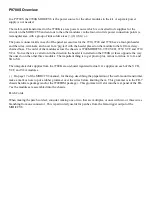
Cell Connections – Cell Cable Overview
43
Chapter 6:
Cell Connections
Cell Cable Overview
The Cell Connectors are two 15-pin D-connectors on the front of the Reference 3000.
The upper (female) connector is labeled Counter/Working. It carries the cell current between the Counter
electrode wire and the Working electrode wires and the instrument.
The lower male connector is labeled Sense Inputs. It contains only high-impedance inputs used to sense
potentials in the cell.
Gamry’s standard cell cables always come in pairs. Each cable has a D-connector on one end and a number of
leads to connect to electrodes in an electrochemical cell. The D-connector end of the cable is connected to the
appropriate D-Connector on the front of the Reference 3000. The male and female cables cannot be
interchanged.
Every Reference 3000 is shipped with a pair of standard shielded cell cables. The Gamry part number for a set
of these two cables is cell cables is 985-00111. They are both 60 cm complex cables, with D-connectors on
one end, and color-coded banana plugs and pin sockets on the other end.
In some cases, your system may also include special-purpose cell cables. The special- purpose cell cables
include documentation describing their use.
Always screw both cell cables into place because cables can fall off the unit. This can be disastrous if it occurs
during an experiment.
Ancillary Apparatus
Do not use the Reference 3000 with ancillary apparatus connected directly to any of the cell leads. Examples of
ancillary apparatus include DVMs, oscilloscopes, chart records, and data loggers. Ammeters and voltmeters,
regardless of their specifications, almost always create problems when connected to the Reference 3000 cell
leads. Ancillary measurement devices can be connected to monitor points on the rear panel of the Reference
3000.
AE Connections
The AE (Auxiliary Electrometers) is an option for the Reference 3000. Its inputs often connect to an
electrochemical device, such as a battery or fuel-cell stack. The inputs can also connect to external
measurement devices, such as a pressure sensor.
AE connections are not described here. See Chapter 8 for AE connection information.
Fuses in the Cell Cable
The Reference 3000 could be damaged if currents much larger than 3 A were to flow into or out of the
Counter electrode or Working electrode leads. Improper connection to a battery, fuel cell, or super-capacitor
could cause this type of damaging current to flow. All Reference 3000 Counter/Working cell cables contain
fuses in the cable to protect the instrument if it is misconnected. A later section of this manual discusses the
fuses and their replacement.
Normal Cell Connections
This section assumes that you are using standard, shielded cell cables. This information does not depend on the
length of the cables.
The cell end of the standard cell cables terminates in a number of banana plugs and two pin jacks. Each
termination comes with a removable alligator clip. Table 6-1 identifies the terminals of the cables.
















































